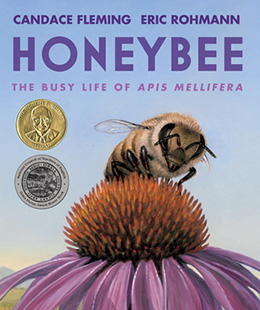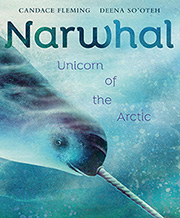BOOKS

illustrated by Eric Rohmann
Neal Porter Books, 2020
978–0823442850
ages 6 and up
buy the book
hardcover
paperback
e‑book
audio book
After you’ve read Honeybee, try this book:
Honeybee
The Busy Life of Apis Mellifera
Fleming and Rohmann, the team behind Giant Squid, offer a fascinating up-close view of the stages of a honeybee’s life. We see our little worker bee go from tiny and gray to full grown and — in a spectacular four-page gatefold — flying for the first time, all the way to the moment on her 35th day when she “drops to the ground” and “stills.” The drama and suspense are positively riveting.
Awards and Recognition
- Robert F. Sibert Award
- AAAS/Subaru SB&F Prize for Excellence in Science Books finalist
- Booklist (starred review)
- Booklist Best Books of 2020
- Booklist Top Ten Biographies
- Bulletin of the Center for Children’s Books (starred review)
- CCBC 2021 Choices List
- Chicago Public Library Best Books of 2020
- Horn Book (starred review)
- Horn Book Best Books list 2020
- Junior Library Guild Gold Standard Selection
- Kirkus Reviews (starred review)
- Kirkus Reviews Best Books of 2020
- National Public Library Best Books of 2020
- NCTE Orbis Pictus Honor Book
- New York Public Library Best Books of 2020
- Publishers Weekly (starred review)
- Publishers Weekly Best Books of 2020
- School Library Journal (starred review)
- School Library Journal Best Books of 2020
- Shelf Awareness (starred review)
- Shelf Awareness Best Books of 2020
- Texas Bluebonnet Master List
Reviews
“Prior to the title page, two full-page close-ups show a honeybee emerging from her wax cell. The free verse poem that runs through the entire book helps readers envision the start of this life cycle. The text and the accompanying illustrations work together masterfully. The vocabulary is precise and razor sharp: each word makes an impact, adding a crucial detail. The language also generates and sustains curiosity. … Rohmann’s illustrations make a dramatic transition. The previous oil-on-paper illustrations are amazingly detailed, large, and easy to examine. The warm colors of the hive (brown, black, yellow) show a safe, secure environment. But as Apis Mellifera peers out from the hive, the perspective radically changes, and a four-page gatefold of a sunny meadow with a field of flowers is visible. Readers follow the insect through each of her jobs until her end, where a new honeybee takes her place. It’s an impressive cycle. VERDICT This book is nonfiction at its best — a combination of beautifully crafted language and astonishing close-up illustrations. Fleming displays admiration for honeybees and conveys enormous respect for their work.” (Myra Zarnowski, School Library Journal, starred review)
“Tongues lick./ Antennae touch.’ The brief but complex life of a Apis Mellifera — a worker honeybee — is explored with depth in this richly detailed picture book. Fleming uses lyrical language to describe just how jam-packed Apis’s short life is — her jobs include cleaning the nursery, feeding ‘grub-like larvae,’ tending the queen, building comb, food handling, and guarding the hive. ‘At last, on the twenty-fifth day of her life … she leaps from the nest and … FLIES!’ Apis lives only 10 days more: ‘She has visited thirty-thousand flowers. She has collected enough nectar to make one-twelfth of a teaspoon of honey.’ Though ‘Apis stills,’ Fleming renders her humble life a mesmerizing wonder. Rohmann’s realistic oil-on-paper illustrations artfully capture close-up details such as the glisten of transparent wings and the fine hairs covering a bee’s body. An ending schematic identifies bee body parts, while supplemental materials offer more facts and details about helping the insects.” (Publishers Weekly, starred review)
“A worker bee breaks out of her honeycomb cell and begins a task-filled life in her colony. The ‘teeming, trembling flurry’ of bees within the close confines of the dark hive is impressively portrayed in Rohmann’s honey-toned illustrations through extreme close-ups and varying perspectives on bee bodies. For the first twenty-four days of her life, the bee remains in the hive, tidying up, nursing larvae, grooming the queen, and performing other vital tasks, all while developing her own strength. With each stage of growth, the text builds anticipation through repetition: will the next stage be ‘Flying? / Not yet.’ Partway through the book, on day twenty-five, the bee finally emerges above a sunlit meadow on a four-page foldout; she flies into the next stage of existence as a pollinator. After ten days of nectar collection (during which she produces ‘one-twelfth of a teaspoon of honey’), the bee dies, and a new bee emerges from a cell. As with the author-illustrator pair’s Giant Squid, the art and text together convey a holistic view of environment and organism, with excellent pacing through the complete bee life cycle. A diagram of bee anatomy is appended, and a ‘Helping Out Honeybees’ note discussing the importance of honeybees to human food production and threats to their existence, with a reading list and websites, concludes the book.” (The Horn Book, starred review, Danielle J. Ford)
“The detail and whimsy of the honeybee’s biography beautifully portray her as a vital part of Earth’s ecosphere, setting up the delicate insect to be appreciated by young readers for her hard work and enormous contributions. Each page of Fleming’s text brims with information, presented with a poetic tone and capped off with a cliff-hanger, egging the reader on to the next stage of life … Rohmann’s striking, life-like oil paintings accompany Fleming’s intriguing text. The meticulous detail and large-scale, bug’s-eye view emphasize both the honeybee’s delicacy and her great importance. Minute features like the veins in her wings and the pollen in her hair are sure to mesmerize young audiences. In contrast, an equally beautiful gatefold reminds readers how tiny she is in the world we inhabit. This dazzling picture book includes an essay and additional facts in the back matter, culminating in a phenomenal portrait of a tiny but indispensable component of nature — truly a delightful learning experience.” (Shelf Awareness, starred review)
“[Fleming] maintains narrative tension through artfully deployed delayed gratification, ending each topical spread by hinting that Apis’ “new job” might involve “flying?” only to reveal a different nest-bound activity for Apis with a page turn. Rohmann rises to the challenge of a story mostly set in dark, confined quarters and a limited palette of black, brown, and honey yellow with stunning views of Apis and her sisters, each tiny hair and segment lovingly delineated. Neither text nor illustrations anthropomorphize their subject; Apis never complains. But an astonishing double gatefold depicts her finally flying over a field of purple and yellow wildflowers into an endless blue sky, liberating bee, creators, and readers alike. Several pages of backmatter offer further information about honeybees, online resources, and child-appropriate books. Like its subject, a wonder to behold.” (Kirkus Reviews, starred review)
“Even if the shelves sag with primary-grade books on the life cycle of the honeybee, make room for this exceptional offering. Oversized trim and a text artfully attuned to reading aloud work in harness together to rivet listeners as they follow Apis mellifera, nicknamed Apis throughout, as she ‘squirms, pushes, chews through the wax cap of her solitary cell and into … a teeming, trembling flurry.’ … Rohmann’s much larger than life oil paintings of so eventful a thirty-five-day life leave the audience momentarily bereft at the end of their intense involvement with personalized, but not anthropomorphized, Apis. New life emerging within the nest implicitly continues the story, though, and four pages of extensive back matter, including a large diagram on bee physiology, are on hand to guide further exploration.” (Bulletin of the Center for Children’s Books, starred review)
“Yet another picture book about bees? Yes, indeed! Glorious illustrations and engaging text combine to present readers with an up-close look at the life of a honeybee. The action jumps right in, beginning even before the title page, as a new bee chews her way out of her birth chamber and immediately starts working to support her hive. The present-tense text employs simple, straightforward sentences to describe her day-to-day development, with every page ending with the question ‘Is she going to fly now?’ The answer remains ‘No!’ for the first 25 days, until, finally, in a glorious four-page foldout, she soars away over a meadow. Ten days later, her time is up, and she peacefully curls up on the forest floor just as another honeybee is born. The vivid oil paint illustrations include minute details and, at times, seem indistinguishable from photographs. The pictures align perfectly with the text, showing the honeybee hard at work at various tasks. Back matter includes a physical diagram, ways humans can help bees, facts, trivia, and additional resources. Whether used to support inquiry projects or as a stunning storytime selection, this offering will captivate audiences.” (Booklist, starred review)


